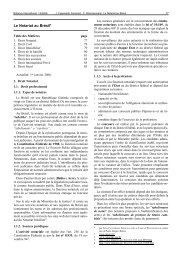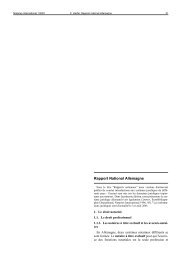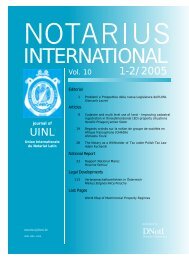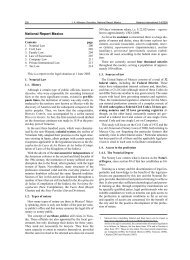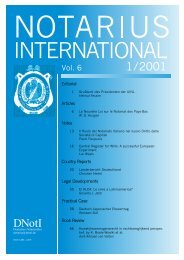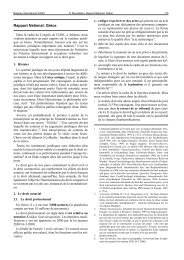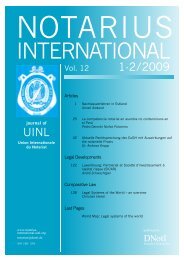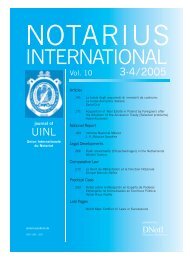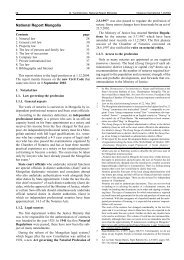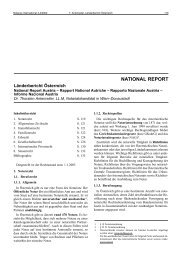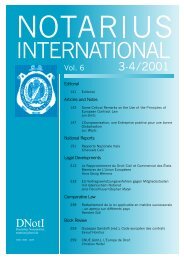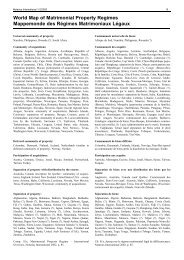ARTICLES and NOTES - Notarius International
ARTICLES and NOTES - Notarius International
ARTICLES and NOTES - Notarius International
You also want an ePaper? Increase the reach of your titles
YUMPU automatically turns print PDFs into web optimized ePapers that Google loves.
<strong>Notarius</strong> <strong>International</strong> 3-4/2002 T. Antenreiter, National Report Austria 137<br />
be an owner partnership consisting of any two natural<br />
persons 18 . In addition, the Law permits residential property<br />
ownership to be created only if it is created in the<br />
whole building, so that so-called “mixed tenure houses”<br />
(Mischhäuser; simple co-ownership along with lease<br />
agreements on the one h<strong>and</strong> <strong>and</strong> residential property<br />
ownership on the other h<strong>and</strong>) should gradually disappear.<br />
The Law on Building Rights allows a piece of l<strong>and</strong> to<br />
be burdened with the real, transferable <strong>and</strong> inheritable<br />
right to have a building structure on or under the surface<br />
of the ground (building right or building lease) 19 . A<br />
building right can be created for a minimum period of ten<br />
years <strong>and</strong> a maximum of 100 years <strong>and</strong> is registered in<br />
the L<strong>and</strong> Register by means of a separate building right<br />
insertion. As a rule the owner of the burdened l<strong>and</strong> receives<br />
annual building interest. The owner of the building<br />
right is also owner of the building erected on the l<strong>and</strong><br />
as an appurtenance, but it passes to the owner of the l<strong>and</strong><br />
when the building right expires 20 .<br />
3.5. Restricted real interests in l<strong>and</strong><br />
The restricted real interests in l<strong>and</strong> recognised by Austrian<br />
law are rights of lien (mortgage) 21 , easements (also<br />
called servitudes, which oblige the owner of the l<strong>and</strong><br />
merely to tolerate something or to refrain from doing<br />
something, not to take any active measures; this includes,<br />
for instance, rights of vehicular access, rights of way,<br />
wayleaves for pipes, cables etc., occupancy rights <strong>and</strong><br />
usufructary rights) 22 <strong>and</strong> charges on l<strong>and</strong> (Reallasten –<br />
representing personal liability on the part of the current<br />
owner of the l<strong>and</strong> to perform, as a rule, recurring services,<br />
such as, for instance, providing for a retired farmer<br />
after transfer of the farm to a descendant (Ausgedingeleistungen)<br />
23 together with other rights which, on the basis<br />
of special statutory directive, can be registered in the<br />
L<strong>and</strong> Register (leasing rights 24 , rights of pre-emption <strong>and</strong><br />
rights to repurchase 25 , prohibitions on selling or burdening<br />
the property 26 ).<br />
4. Family law<br />
4.1. Matrimonial law <strong>and</strong> co-habitation relationships<br />
4.1.1. Marriage <strong>and</strong> divorce<br />
Austrian law regulates matters relating to marriage <strong>and</strong><br />
divorce in the General Civil Code 27 <strong>and</strong> in the Matrimonial<br />
Law (Ehegesetz: EheG). A marriage is always<br />
dissolved by a court decision 28 , but there is the possibility<br />
of simplified divorce by mutual consent in the case<br />
of a joint petition by both spouses <strong>and</strong> prior separation for<br />
at least six months 29 .<br />
4.1.2. Statutory matrimonial property regime, matrimonial<br />
property regime of choice <strong>and</strong> marriage contract<br />
The statutory matrimonial property regime during the<br />
currency of a marriage is the system of separation of<br />
property, which means that each spouse keeps the assets<br />
brought into the marriage by him or her, is sole owner of<br />
the assets acquired by him or her <strong>and</strong> is sole debtor as regards<br />
his/her creditors <strong>and</strong> sole creditor as regards his/her<br />
debtors 30 . In principle there are no reciprocal consent requirements<br />
with regard to management of the assets, but<br />
the spouse liable to provide maintenance, who has authority<br />
to dispose of the matrimonial home, must refrain<br />
from doing anything <strong>and</strong> take all necessary precautions to<br />
ensure that the spouse who stays at home does not lose<br />
it 31 .<br />
The spouses are, however, free to agree another matrimonial<br />
property regime (inter vivos matrimonial<br />
property regime, matrimonial property regime mortis<br />
causa, matrimonial property regime of joint ownership of<br />
subsequently acquired property), for which the drawing<br />
up of a notarial instrument is stipulated 32 .<br />
If no agreement to the contrary is reached, in principle<br />
the system of separation of property continues also in the<br />
event of a divorce, but in this event, on the application of<br />
even only one of the spouses, all the matrimonial assets<br />
will be shared out between the spouses in accordance<br />
with specified apportionment principles 33 . The apportionment<br />
of the assets is carried out by the divorce judge<br />
on a no-fault basis taking account of principles of fairness.<br />
There are no formal requirements in relation to<br />
contractual agreements reached in the course of the divorce<br />
concerning the consequences of the divorce, but<br />
they are subject to inspection as to their contents by the<br />
divorce judge.<br />
Contractual agreements which purportedly settle the<br />
apportionment of assets in advance are only permissible<br />
to a limited degree. In accordance with the provisions of<br />
the Matrimonial Law the claim for apportionment of the<br />
matrimonial assets for everyday use (including the matrimonial<br />
home) cannot be waived effectively in advance<br />
<strong>and</strong> any agreement in advance concerning apportionment<br />
of the matrimonial savings requires to be in the form of a<br />
notarial instrument in order to be legally effective as a<br />
matrimonial covenant 34 .<br />
4.1.3. Maintenance for spouse<br />
Under Austrian law spouses can reach agreement about<br />
the maintenance to be provided during the currency of the<br />
marriage 35 <strong>and</strong> about the obligation to provide mainte-<br />
18 Art. 2 Law on Ownership of Residential Property <strong>and</strong> Arts. 13ff Law<br />
on Ownership of Residential Property; In contrast, under the former<br />
legal position only an individual (natural or juristic) person or married<br />
couple could be the owner, not, however other combinations of people<br />
(siblings, co-habitees, outside persons).<br />
19 Art. 1 Law on Building Rights<br />
20 Art.9 Law on Building Rights (as a rule in return for compensation)<br />
21 Arts. 447ff ABGB (General Civil Code)<br />
22 Arts. 473 ABGB (General Civil Code)<br />
23 Art. 12 L<strong>and</strong> Registry Law<br />
24 Art.1095 ABGB (General Civil Code)<br />
25 Arts.1068ff <strong>and</strong> 1072ff ABGB (General Civil Code)<br />
26 Art.364c ABGB (General Civil Code)<br />
27 Arts. 44 to 100 ABGB (General Civil Code)<br />
28 Art.46 Matrimonial Law<br />
29 Art.55a Matrimonial Law<br />
30 Arts. 1233 <strong>and</strong> 1237 ABGB (General Civil Code)<br />
31 Art.97 ABGB (General Civil Code)<br />
32 Arts.1217ff ABGB (General Civil Code) <strong>and</strong> Art. 1 Law on Notaries<br />
Public<br />
33 Arts.81ff Matrimonial Law<br />
34 Art. 97 Matrimonial Law <strong>and</strong> Art.1 Law on Notaries Public<br />
35 Art. 91 para.1 ABGB (General Civil Code)



